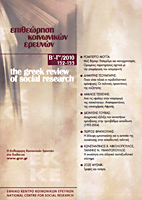Time-trends of inequalities in access to higher education (1993-2004): Signs of reversal of trends after the implementation of the "Arsenis Reform"
Abstract
A very important part of the so-called «Arsenis Reform» dealt with the access to the Greek higher education, through a reorganization of the lyceum (upper-secondary school). Main aim of this study is the analysis of time-trends of access to higher education, through the system of the national (university-entrance) examinations, at three different time-spots (i.e. academic years 1993-94, 1998-99 και 2003-04), in relation to the occupational and educational grouping of the students' parents. Through the use of «indices of representation at various Higher Education establishments and/or academic departments, there is an attempt to: a) highlight the main longitudinal trends in access patterns; b) link the various scientific disciplines (and their status) to general trends in the Greek labour market; and c) provide an initial assessment of the «Arsenis Reform», as far as it concerns one of its main declared aims, that is the advancement of «equality of opportunities»
Article Details
- How to Cite
-
Γουβιάς Δ. (2010). Time-trends of inequalities in access to higher education (1993-2004): Signs of reversal of trends after the implementation of the "Arsenis Reform". The Greek Review of Social Research, 132, 99–145. https://doi.org/10.12681/grsr.16
- Issue
- 2010: 132-133, Β-C
- Section
- Articles

This work is licensed under a Creative Commons Attribution-NonCommercial 4.0 International License.
Authors who publish with this journal agree to the following terms:
- Authors retain copyright and grant the journal right of first publication with the work simultaneously licensed under a Creative Commons Attribution Non-Commercial License that allows others to share the work with an acknowledgement of the work's authorship and initial publication in this journal.
- Authors are able to enter into separate, additional contractual arrangements for the non-exclusive distribution of the journal's published version of the work (e.g. post it to an institutional repository or publish it in a book), with an acknowledgement of its initial publication in this journal.
- Authors are permitted and encouraged to post their work online (preferably in institutional repositories or on their website) prior to and during the submission process, as it can lead to productive exchanges, as well as earlier and greater citation of published work (See The Effect of Open Access).
Downloads
Download data is not yet available.



